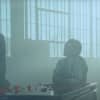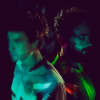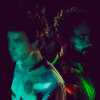The talent that brought you the videos for MGMT's "Time To Pretend" and "Electric Feel" has yet another tripped-out video for eager eyes and ears. With their video for Saul Williams' "Convict Colony", co-directors Chris Edley and Rob Leitzell set out to superimpose Saul into mystifying desert landscapes and nightmarish situations involving multiple other Sauls. It took them weeks and weeks to explode our minds with psychotropic images of Niggy Stardust hanging out with his animal spirit, so we figured we'd ask them what took so long. Read up about this video, and other videos produced by these Gondry-endorsed guys, after the jump in our interview with Chris.
You just recently directed the Saul Williams video for “Convict Colony”. How did that work out?
It’s actually kind of strange. He sent an email to my friend Ray Tintori saying “I’m looking for treatments for this video. You got any ideas?” And we had just finished doing the Electric Feel video for MGMT. I did production design. Ray emailed me and said, “I don’t have time to do this because I’ve got post production. I think you should do this. Here’s the track.” And so I listened to the song about 20 or 30 times in a row and started brainstorming, came up with an idea, and a couple of days later to my extreme surprise they wrote back and said, “lets go ahead.” And then my idea changed a bit and I started talking to Saul on the phone.
How did the idea change once you started collaborating with Saul?
I think it got weirder. It got more out there in terms of what he was willing to do for the nightmarish quality of the video and this sort of multiple-self, John Malkovich sort of thing. It also took realizing how amazing of a performance we could get out of him – that we could, in what ended up being a 16 hour shoot, rely on him being an unbelievably good performer and have the whole thing really rely on his acting abilities.
He’s pretty high energy. Was he able to sustain that throughout the shoot?
It was unbelievable. He was just, from start to finish, never slipping an inch, just always completely on top of his game.
Did you adhere, for the most part, to the idea behind the song?
Absolutely. Ray Tintori sort of first perked my ear, saying that you just can’t make a good music video unless you’re really paying attention to the band and talking to the band or the artist. It’s an interesting medium – you look at old films, and there will be these three or four minute patches where it’s actual motion photography and it’s just beautiful visual art, and it moves. We’ve got that nowadays with cinema, but it’s so overwhelmed. A music video is one of the only places that you can really do motion photography, but it needs to have something to do with what’s going on. The video is pretty literal, but I’m certainly interested in the nightmare aspect, and a nightmare never makes complete sense.
Did you draw from any of the Ziggy Stardust, or did you try stay away from that?
Saul, as the character of Niggy, really relates to horses, birds and hyenas as his spirit animals. So I definitely wanted to put that in, and as I was starting to do stuff with horses and birds, it really felt that Saul was onto something—very much the apocalyptic stuff. There’s all of this old stock footage of nuclear fallout from buildings being completely blown away in the background, and I think that it’s really departing from a plane of normality.
How long did it take?
I think it was a month and a half of three of us working on average 18 hours a day, five or six days a week. It was crazy. Rob Leitzell was the one who did the superfine backgrounds where it does actually look like a real place but in a dream. He’s extraordinary.
You do a lot of work with blue screens. Do you have exact background images in mind when you shoot or do you improvise in post?
With this video we had a really clear script of what we wanted to have happen, and I think about 12 or 16 hours before the shoot we really had it figured out – exactly what we needed to get and not a terrible much more to fudge with. So we were really lying on the shoot date. But with "Time to Pretend" it was making a lot of stuff up, and I think that was brilliant for that video and really wound up making something ecstatic and crazy. I think the Saul video is a little more controlled in that it’s a straight narrative, which helps.
The video for “Time To Pretend” is probably the most striking visual imagery I’ve seen all year. As the art director, how much of that were you responsible for?
I started doing a lot of the props. There were these really fantastic teepees that actually didn’t even get used, but we worked our asses off on them. Then I got moved over to costumes, did a lot of the costume stuff, and then on shoot days I would take care of everything in front of the camera.
What’s the deal with the giant cat?
That’s actually Rob’s cat. There’s this old Busta Rhymes video for the song, “Put Your Hands Where My Eyes Can See.” It’s absolutely my favorite music video ever. And there’s this one part where he’s running down this hallway, and you have this over-his-right-shoulder perspective, and he’s looking back up at you from time to time, and you’re like “What the hell is this point of view, and where is this coming from?” And then they shoot him from the front, and there’s an elephant, and you’re like “Okay, now literally anything can happen.” I call it the elephant shot—if you start out pretty absurd, you’re either going to plateau and be stuck on this level of absurdity and people are going to get a little bored, or you have an elephant shot, and you can go anywhere. So I think the cat functions as the elephant shot in Time to Pretend. And then it’s actually acceptable to have a paper drawing of a monster in flash animation that explodes into dolphins. You can actually do anything you want after that.


